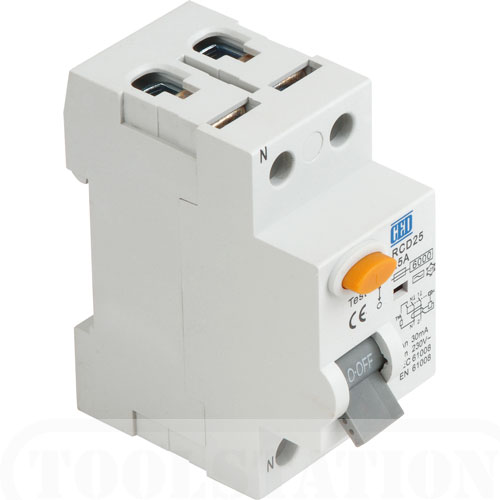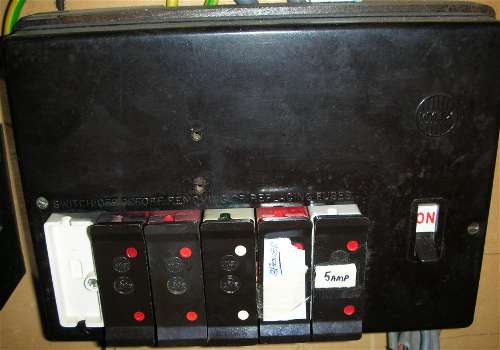RCD protection types

RCD 1
Upstairs Lights,
Downstairs Final Ring Main,
Garage Sockets,
Shower
RCD 2
Downstairs Lights,
Upstairs Sockets,
Cooker,
Heating,
By alternating the circuits like this, power will always be present on one floor if either RCD trips out.
Another way to protect circuits under the 17th Edition IEE Wiring Regulations is by fitting Residual Current Circuit Breaker With Overload (RCBOs) to every circuit although this can be a very costly method.
Fuse Boxes usually use cartridge or rewirable fuses with no other protective device, and basic 4-ways boxes are very common. Some older boxes are made of brown-black bakelite, sometimes with a wooden base. Although their design is historic, these were standard equipment for new installs as recently as the 1980s, so they are very common. Fuseholders in these boxes may not provide protection from accidental contact with live terminals.
The popular 4-way fusebox usually has two lighting and two socket circuits, with heavy or sustained loads such as immersion heater and oven on a socket circuit. This arrangement is not recommended practice today, as electricity usage has substantially grown in the last 20 years, but it is still in some existing installations. Larger boxes with more ways will have separate fuses for large loads such as immersion heater, oven and shower.
Circuit breaker retrofits
Some of these fuseboxes have had their fuse carriers replaced with plug-in miniature circuit breakers. These retrofit MCBs are typically rated at 3kA breaking capacity, but many homes or properties have prospective short circuit currents as high as 6kA. Fault currents of over 3kA are thus interrupted by the incomer fuse, should they ever occur, and the MCB would not survive. [citation needed]
Historic fuseboxes
 A small number of pre-1950 fuseboxes are still in service. These should be treated with caution because exposed live parts are common on these boxes. The installations they supply will not meet modern standards for electrical safety. Another characteristic of very old installations is that there may be two fuses for each circuit; one on the live and one on the neutral. In rare instances, old ring circuits may be encountered with no less than 4 15 A fuses per ring, one on each of L and N, and this duplicated for each of the 2 feeds for the ring.
A small number of pre-1950 fuseboxes are still in service. These should be treated with caution because exposed live parts are common on these boxes. The installations they supply will not meet modern standards for electrical safety. Another characteristic of very old installations is that there may be two fuses for each circuit; one on the live and one on the neutral. In rare instances, old ring circuits may be encountered with no less than 4 15 A fuses per ring, one on each of L and N, and this duplicated for each of the 2 feeds for the ring.
Inside a UK distribution board
 This picture shows the interior of a typical 12-position UK distribution panel. The incoming live cable connects to the busbars via a main dual pole isolator switch on the left of the panel. This isolator switches both the live and the neutral feeds on and off at the same time. Power comes in to the top of the isolator and so out of the bottom must come twp cables to go behind the DIN rail and into the top of both RCD’s. In this diagram the neutral comes out of the bottom of the isolator and into a central neutral terminal bar but often, just as the live, two cables will come out of the bottom of the isolator behind the DIN bar and into the top of the RCD’s. Once the RCD’s become live and they in turn are asitched on power comes out of the bottom of the RCD’s and into the bus bars to which all the other MCB’s are connected. The cables to the individual circuits are then fixed into to the top of the MCB’s. In the finished consumer unit, even once the cover is removed there will be a plastic shield covering these bus bars so as to give extra protection.
This picture shows the interior of a typical 12-position UK distribution panel. The incoming live cable connects to the busbars via a main dual pole isolator switch on the left of the panel. This isolator switches both the live and the neutral feeds on and off at the same time. Power comes in to the top of the isolator and so out of the bottom must come twp cables to go behind the DIN rail and into the top of both RCD’s. In this diagram the neutral comes out of the bottom of the isolator and into a central neutral terminal bar but often, just as the live, two cables will come out of the bottom of the isolator behind the DIN bar and into the top of the RCD’s. Once the RCD’s become live and they in turn are asitched on power comes out of the bottom of the RCD’s and into the bus bars to which all the other MCB’s are connected. The cables to the individual circuits are then fixed into to the top of the MCB’s. In the finished consumer unit, even once the cover is removed there will be a plastic shield covering these bus bars so as to give extra protection.
Things to note.
The MCB’s will be in descending order of value, i.e., 40amp, 32amp, 32amp, 16amp and a 6amp. And that the MCB’s on the left hand side of the board will have their corresponding neutrals attached to the left of the two neutral bars. It is important to note that if you have even one of the neutrals from the left side going into the right hand bar the board will never power up properly and you will always have nuisance tripping if you can even get it to stay on for longer than a few seconds.
The incoming earth wire connects directly to the earth bar on the top right of our diagram to which all the other earths are connected to.
For reasons of aesthetics and security, circuit breaker panels are often placed in out-of-the-way closets, attics, garages, or basements, but sometimes they are also featured as part of the aesthetic elements of a building (as an art installation, for example) or where they can be easily accessed. However, current building codes prohibit installing a panel in a bathroom (or similar room), in closets intended for clothing, or where there is insufficient space for a worker to access it. Specific situations, such as an installation outdoors, in a hazardous environment, or in other out-of-the-ordinary locations may require specialized equipment and more stringent installation practices.
